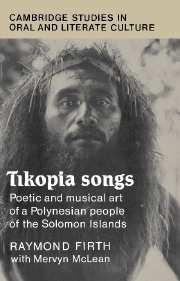Book contents
- Frontmatter
- Contents
- ILLUSTRATIONS
- FIGURES
- Preface
- Acknowledgements
- Sketch map of Tikopia (approx. 5 sq. km.)
- Part I General
- Part II Musical analysis (by Mervyn McLean)
- Part III Song texts, translations and commentary
- 6 Dance songs of everyday life
- 7 Songs of the sea and of travel
- 8 Eulogies and farewells
- 9 Songs of protest and criticism
- 10 Songs of erotic arousal and sex antagonism
- 11 Laments and funeral dirges
- 12 Songs on historical and mythic themes, and of ritual quality
- 13 Epilogue
- Appendix 1 Composers to whom songs attributed
- References
- Index
8 - Eulogies and farewells
Published online by Cambridge University Press: 07 May 2010
- Frontmatter
- Contents
- ILLUSTRATIONS
- FIGURES
- Preface
- Acknowledgements
- Sketch map of Tikopia (approx. 5 sq. km.)
- Part I General
- Part II Musical analysis (by Mervyn McLean)
- Part III Song texts, translations and commentary
- 6 Dance songs of everyday life
- 7 Songs of the sea and of travel
- 8 Eulogies and farewells
- 9 Songs of protest and criticism
- 10 Songs of erotic arousal and sex antagonism
- 11 Laments and funeral dirges
- 12 Songs on historical and mythic themes, and of ritual quality
- 13 Epilogue
- Appendix 1 Composers to whom songs attributed
- References
- Index
Summary
A eulogy, in classical expression, was a speech of praise, especially praise of a dead person, and taking the form of a set oration. In a Tikopia context, the term may be extended to cover statements of praise or commendation made in the set form of poetry, and treated musically, as song. Moreover, in Tikopia, sensibly enough, a song eulogy has often been addressed to a living person, who can recognise the honour and suitably reward the composer. Many of these eulogies have been composed in dance form, varying as ngore, matāvaka, mori, tūngaunu, tusoko, mako po according to the composer's whim. But many others - about half of those I have cited here - have been composed as fuatanga, in lament form. This I interpret as a token, not of sadness or grief, but of emotional sensitivity. The composer has felt moved by thought of the qualities of generosity, hospitality etc. celebrated in the song, and so has couched the tribute in grave rather than in gay mode. As such the context of performance demanded is different; a dance song is chanted to accompany the physical acts of recreation, while a lament is chanted on more solemn occasions, as a feast given by a chief, or a ritual event expressing sympathy with a boy about to be initiated.
A particular kind of eulogy, in lament style, is the soa. As its name implies, this is a type of song which is based upon a relation of amity, of which prime examples are the relation between spouses, and between bond friends (for whom the reciprical term is also soa).
- Type
- Chapter
- Information
- Tikopia SongsPoetic and Musical Art of a Polynesian People of the Solomon Islands, pp. 162 - 189Publisher: Cambridge University PressPrint publication year: 1991



